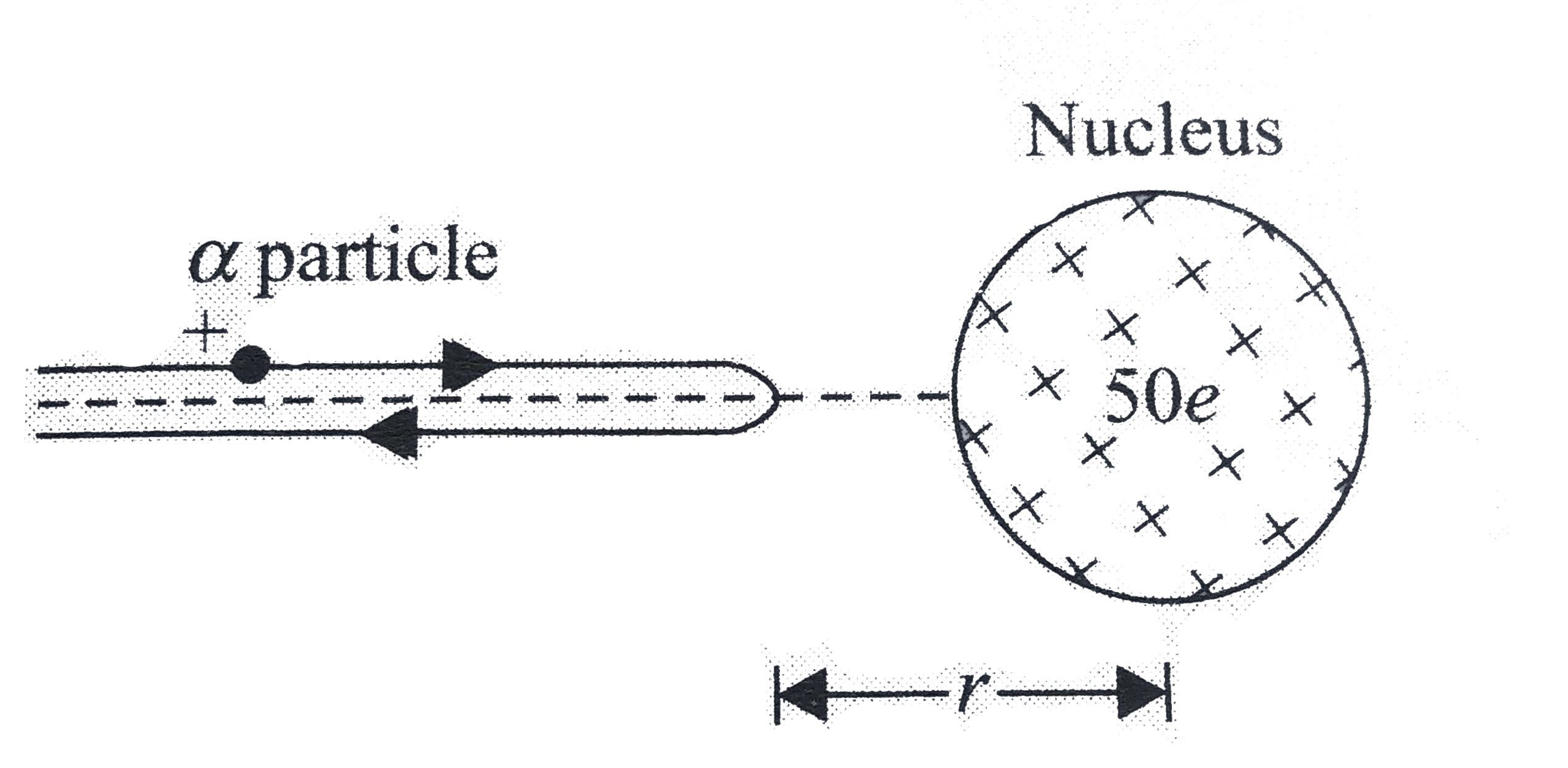A beam of beryllium nucleus (z = 4) of kinetic energy 5.3 MeV is headed towards the nucleus of gold atom (Z = 79). What is the distance of closest approach?
10.32×10−14m
8.58×10−14m
3.56×10−14m
1.25×10−14m
The correct Answer is:B
To find the distance of closest approach between a beryllium nucleus and a gold nucleus, we can use the concept of conservation of energy. The kinetic energy of the beryllium nucleus will be converted into electrostatic potential energy at the point of closest approach.
1. Identify the Given Values:
- Charge of beryllium nucleus (Z1) = 4 (since beryllium has atomic number 4)
- Charge of gold nucleus (Z2) = 79 (since gold has atomic number 79)
- Kinetic energy (KE) of the beryllium nucleus = 5.3 MeV
2. Convert Kinetic Energy to Joules:
- 1 MeV = 1.6×10−13 Joules
- Therefore, KE = 5.3MeV=5.3×1.6×10−13J=8.48×10−13J
3. Calculate the Electrostatic Potential Energy at Closest Approach:
- The potential energy (PE) between two point charges is given by:
PE=k⋅Z1⋅Z2⋅e2r
where:
- k=8.99×109N m2/C2 (Coulomb's constant)
- e=1.6×10−19C (charge of an electron)
- r is the distance of closest approach.
4. Set Kinetic Energy Equal to Potential Energy:
- At the point of closest approach, the kinetic energy is converted to potential energy:
KE=PE
8.48×10−13=(8.99×109)⋅(4)⋅(79)⋅(1.6×10−19)2r
5. Rearranging to Solve for r:
- Rearranging the equation gives:
r=(8.99×109)⋅(4)⋅(79)⋅(1.6×10−19)28.48×10−13
6. Calculating the Values:
- First calculate (1.6×10−19)2=2.56×10−38
- Then calculate:
r=(8.99×109)⋅(4)⋅(79)⋅(2.56×10−38)8.48×10−13
- Calculate the numerator:
=(8.99×109)⋅(4)⋅(79)⋅(2.56×10−38)=8.99×109⋅316⋅2.56×10−38≈7.16×10−25
- Now divide by 8.48×10−13:
r≈7.16×10−258.48×10−13≈8.45×10−13m≈8.45fm
Final Answer:
The distance of closest approach is approximately 8.45fm.
- Charge of beryllium nucleus (Z1) = 4 (since beryllium has atomic number 4)
- Charge of gold nucleus (Z2) = 79 (since gold has atomic number 79)
- Kinetic energy (KE) of the beryllium nucleus = 5.3 MeV
- 1 MeV = 1.6×10−13 Joules
- Therefore, KE = 5.3MeV=5.3×1.6×10−13J=8.48×10−13J
- The potential energy (PE) between two point charges is given by:
PE=k⋅Z1⋅Z2⋅e2r
where:
- k=8.99×109N m2/C2 (Coulomb's constant)
- e=1.6×10−19C (charge of an electron)
- r is the distance of closest approach.
- At the point of closest approach, the kinetic energy is converted to potential energy:
KE=PE
8.48×10−13=(8.99×109)⋅(4)⋅(79)⋅(1.6×10−19)2r
- Rearranging the equation gives:
r=(8.99×109)⋅(4)⋅(79)⋅(1.6×10−19)28.48×10−13
- First calculate (1.6×10−19)2=2.56×10−38
- Then calculate:
r=(8.99×109)⋅(4)⋅(79)⋅(2.56×10−38)8.48×10−13
- Calculate the numerator:
=(8.99×109)⋅(4)⋅(79)⋅(2.56×10−38)=8.99×109⋅316⋅2.56×10−38≈7.16×10−25
- Now divide by 8.48×10−13:
r≈7.16×10−258.48×10−13≈8.45×10−13m≈8.45fm
The distance of closest approach is approximately 8.45fm.
Topper's Solved these Questions
- ATOMS AND NUCLEIBOOK - MTG GUIDECHAPTER - ATOMS AND NUCLEIEXERCISE - NEET CAFÉ (TOPICWISE PRACTICE QUESTIONS)(BOHR MODEL)
19 Videos
- ATOMS AND NUCLEIBOOK - MTG GUIDECHAPTER - ATOMS AND NUCLEIEXERCISE - NEET CAFÉ (TOPICWISE PRACTICE QUESTIONS)(ENERGY LEVELS AND HYDROGEN SPECTRUM)
24 Videos
- ATOMS AND NUCLEIBOOK - MTG GUIDECHAPTER - ATOMS AND NUCLEIEXERCISE - AIPMT/NEET(MCQs)
40 Videos
- CURRENT ELECTRICITY BOOK - MTG GUIDECHAPTER - CURRENT ELECTRICITY EXERCISE - MCQs AIPMT / NEET
32 Videos
Similar Questions
An α-particle of kinetic energy 7.68 MeV is projected towards the nucleus of copper (Z=29). Calculate its distance of nearest approach.
View SolutionAn α-particle with kinetic energy K is heading towards a stationary nucleus of atomic number Z. Find the distance of the closest approach.
View SolutionAn alpha particle with kinetic energy Ki=5.30 MeV happens, by chance,to be headed directly toward he nucleus of a neutral gold atom (fig). What is its distance of closest approach d (least center to center separation) to the nucleus? Assume that the atom remains stationary.
View SolutionAn alpha particle with kinetic energy 10MeV is heading toward a stationary tin nuclcus of atomic number 50. Calculate the distance of closest approach (Fig . 3.23).
 .
.
View SolutionWhat happens to the kinetic energy of the particle at the distance of closest approach?
View SolutionAn alpha particle having KE equal to 8.7MeV is projected towards the nucleus of copper with Z=29. Calculate its distance of closest approach.
View SolutionA 5MeVα particle is projected towards a stationary nucleus of atomic number 40. Calculate distance of closest approach.
View SolutionDefine the distance of closest approach. An α-particle of kinetic enegy 'K' is bombarded on a thin gold foil. The distance of the closest approach is 'r' . What will be the distance of closest approach for an α-particle of double the kinetic energy ?
View SolutionDefine the distance of closest approach. An a particle of kinetic energy K is bombarded on a thin gold foil. The distance of the closest approach is r. What will be the distance of closest approach for an a particle of double the kinetic energy?
Or
Write two important of Rutherford nuclear model of the atom.
View SolutionDefine the distance of closest approach. An a-particle of kinetic energy 'K' is bombarded on a thin gold foil. The distance of the closest approach is 'Y. What will be the distance of closest approach for an a-particle of double the kinetic energy?
View Solution
